

The U.S. Access Board has released an animation on accessible sales and service counters or here in this website as part of its Online guide to standards issued under the Americans with Disabilities Act (ADA) and the Architectural Barriers Act (ABA). The 12-minute animated film shows how access can be achieved to different types of counters, including sales counters and hotel check-in counters. It also covers access to teller and service windows, queues and waiting lines, check-out aisles, food service lines, self-service shelves, and food and beverage dispensers.
"On this day 28 years ago, the ADA became law," states Access Board Executive Director David M. Capozzi. "Providing guidance that helps businesses and agencies to be more welcoming and inclusive of all their customers is a great way for the Board to mark the anniversary of this landmark law."
This animation is the most recent in a series produced by the Access Board. Other animations address wheelchair maneuvering, entrances and doors, toilet and bathing facilities, protruding objects, parking and passenger loading zones, and signs. The animations can be viewed or downloaded through the Board's website. They are also available on the Board's new You Tube channel along with videos about the Board and its work.
The Board's Online guide to the ADA and ABA Standards also features technical bulletins that explain and illustrate requirements and address common questions. Bulletins are currently available on the first five chapters of the standards, including application and scoping, building blocks, accessible routes, accessible means of egress, parking and passenger loading zones, and stairways. The Guide to the ADA Standards covers design requirements for places of public accommodation, commercial facilities, and state and local government facilities subject to the ADA. The Guide to the ABA Standards addresses similar standards that apply under the ABA to facilities that are federally funded.
Future installments to the guides will be released as they become available. Users can sign-up to receive email updates on the release of other animations and bulletins in the series.
The U.S. Access Board has launched its own channel on You Tube to further share and disseminate information. It features a message from Executive Director David M. Capozzi on the Board's mission and the services it provides to the public. Animations on accessibility that the Board has developed as part of its Online guide to the ADA and ABA Accessibility Standards are also available on the channel.
"The Board's new platform on You Tube provides another means of engaging our audience and sharing information," notes Capozzi. "We look forward to uploading additional content in the future."
Visitors can subscribe to receive updates on new material that is added to the channel.
Access - 2018 Valuation Threshold Updated
In accordance with the 2016 California Building Code Chapter 2 definition of Valuation Threshold, the 2018 valuation threshold has increased to $161,298.00. The amount will be updated again in January 2019.
The Valuation Threshold is an annually adjusted figure used in determining the extent of required path of travel upgrades. Additional information on the valuation threshold for alterations, structural repairs or additions to existing buildings is available on DSA's Valuation Threshold web-page.
Please contact your DSA Regional Office with any questions.
Smithsonian Exhibit Puts Focus On Accessible Design
From clothing to utensils and computers, a new exhibit is showcasing the varied and increasing ways that today's world is adapting to accommodate the needs of people with disabilities. Read More +
The Division of the State Architect (DSA) has released a new document, the Electric Vehicle Charging Stations, Accessibility: FAQs, as a part of our ongoing effort to encourage consistency in the design and construction of projects. The FAQs and other resources can be found on DSA’s Electric Vehicle Charging Station Accessibility web-page. Please direct any questions to Ida Clair, principal architect, at (916) 322-2490 or ida.clair@dgs.ca.gov.
Dear accessibility colleague,
As long-time accessibility consultants, we observed a common problem in medical facilities. Patients with mobility challenges had to be awkwardly lifted onto high exam tables, facing serious injury during the transfer. If not lifted onto fixed-height exam tables, they were examined while seated in their wheelchairs in less-than-thorough exams. Many patients couldn't stand to have their weight read and were asked to estimate their weight - something no able-bodied patients were asked to do. Both scenarios illustrate failures by medical facilities to provide equal care to all patients. Not only is this bad medicine and bad for business, it's also a clear ADA violation.
The U.S. Access Board recently published standards for accessible medical equipment. The time is ripe to make this an ADA compliance priority.
Our company has developed an all-in-one equipment solution for accessible medical exams, one that meets and exceeds the Access Board standards - The UpScale. Finally, patients of all abilities can have a head-to-toe exam and have their weight and height measured, too.
The UpScale is a powerful, all-in-one height-adjustable exam table with built-in weight scale, accessible knee stirrups and height measurement tool - designed by ADA experts for maximum compliance and patient safety.
Click on the video below to learn more about:
• Avoiding ADA lawsuits.
• Improving patient and staff safety through better safe patient handling.
• Saving money and space with an affordable two-in-one design.
Under the ADA and Section 504, medical equipment must be accessible to patients of all abilities. Make this a compliance priority and help create a safer exam experience with the UpScale.
Contact me for more information about medical equipment access and our referral program.
Paul Farber
Vice President - Compliance and Operations
Medical Accessibility LLC | We Make Accessible
602.402.9544
pfarber@medicalaccessibility.com
www.medicalaccessibility.com
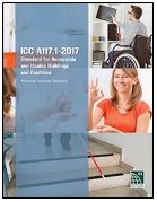 The American National Standards Institute (ANSI) recently approved the 2017 edition of the ICC A117.1 Standard on Accessible and Usable Buildings and Facilities. This voluntary consensus standard, which provides technical provisions for accessible spaces and elements in facilities, is referenced by the International Building Code (IBC). (The 2018 IBC will reference the prior edition of the ICC A117.1 Standard, so jurisdictions that wish to implement the 2017 edition will have to adopt it specifically.)
The American National Standards Institute (ANSI) recently approved the 2017 edition of the ICC A117.1 Standard on Accessible and Usable Buildings and Facilities. This voluntary consensus standard, which provides technical provisions for accessible spaces and elements in facilities, is referenced by the International Building Code (IBC). (The 2018 IBC will reference the prior edition of the ICC A117.1 Standard, so jurisdictions that wish to implement the 2017 edition will have to adopt it specifically.)
The new edition features enhanced requirements for clear floor space, turning space and accessible routes based on new research on human measures and wheeled mobility. It also includes new provisions covering acoustics in classrooms, electric vehicle charging stations, and components in public rights-of-ways such as curb ramps, blended transitions, detectable warnings, and on-street parking. The International Code Council (ICC), which maintains the IBC and serves as the secretariat for the ANSI A1171 Committee, will publish the new standard in June. Visit the ICC's website for further information.
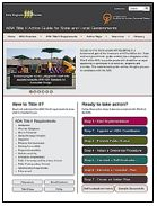 The New England ADA Center has released an Online ADA Action Guide for State and Local Governments to help public sector entities understand and fulfill their obligations under the law. The guide explains provisions in title II of the ADA, including requirements for effective communication and access to facilities and programs. It also decribes actions that state and local governments must take, such as appointing an ADA Coordinator, establishing grievance procedures, conducting self-evaluations, and implementing transition plans. The material includes sample documents and self-evaluation forms, answers to frequently asked questions, and best practices. Further information is available on the New England ADA Center's website.
The New England ADA Center has released an Online ADA Action Guide for State and Local Governments to help public sector entities understand and fulfill their obligations under the law. The guide explains provisions in title II of the ADA, including requirements for effective communication and access to facilities and programs. It also decribes actions that state and local governments must take, such as appointing an ADA Coordinator, establishing grievance procedures, conducting self-evaluations, and implementing transition plans. The material includes sample documents and self-evaluation forms, answers to frequently asked questions, and best practices. Further information is available on the New England ADA Center's website.
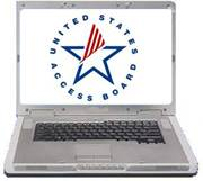 The next webinar in the Board's free monthly series will take place July 6 from 2:30 – 4:00 (ET) and review requirements in the ADA and ABA Accessibility Standards for courthouses. It will cover access to courtrooms, including jury boxes, witness stands, and judges' benches, as well as other spaces and elements of courthouses, such as secured entrances and holding cells.
The next webinar in the Board's free monthly series will take place July 6 from 2:30 – 4:00 (ET) and review requirements in the ADA and ABA Accessibility Standards for courthouses. It will cover access to courtrooms, including jury boxes, witness stands, and judges' benches, as well as other spaces and elements of courthouses, such as secured entrances and holding cells.
The following webinar in this series on August 3 will present findings from a study sponsored by the Board that assessed the impacts of rough and uneven surfaces on wheelchair travel.
Visit www.accessibilityonline.org for more information or to register for the webinars. Questions can be submitted in advance of the session or can be posed during the webinar. Webinar attendees can earn continuing education credits. The webinar series is hosted by the ADA National Network in cooperation with the Board. Archived copies of previous Board webinars are available on the site.
Section 508 Best Practices Webinar
The Board also offers a free webinar series on standards issued under Section 508 of the Rehabilitation Act which requires access to information and communication technology in the federal sector. This year's sessions focus on the updated Section 508 Standards published by the Board in January. The next webinar in this series is scheduled for July 25 from 1:00 to 2:30 (ET) and will review requirements for hardware, including mobile devices, in Chapter 4 of the revised 508 Standards. Presenters will cover provisions for speech-output for devices with display screens, access to two-way voice communication, privacy, closed captioning, audio description, operable parts and user controls.
For more details or to register for this session, visit www.accessibilityonline.org/cioc-508/schedule. The Section 508 Best Practices Webinar Series is made available by the Accessibility Community of Practice of the CIO Council in partnership with the Board
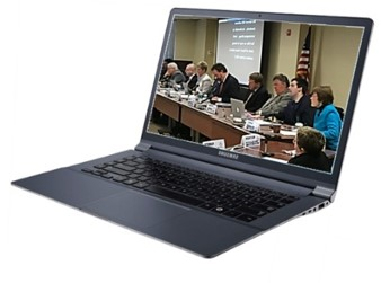 The Access Board will hold its next meeting July 12 from 1:30 – 3:00 (ET) at the Board's conference space in downtown Washington, D.C. The public is welcome to attend in person or through a live webcast of the meeting.
The Access Board will hold its next meeting July 12 from 1:30 – 3:00 (ET) at the Board's conference space in downtown Washington, D.C. The public is welcome to attend in person or through a live webcast of the meeting.
A public comment period will be held during the final 15 minutes of the meeting. Those interested in making comments in person or by phone should send an email to Rose Bunales at bunales@access-board.gov with "Access Board meeting - Public Comment" in the subject line. Please include your name, organization, state, and topic of your comment in the body of the message.
Meeting of the U.S. Access Board July 12, 1:30 – 3:00
Webcast link: www.access-board.gov/webcast Access Board Conference Center 1331 F Street, NW, Suite 800
Washington, D.C.
Note: For the comfort of all participants and to promote a fragrance-free environment, attendees are requested not to use perfume, cologne, or other fragrances.
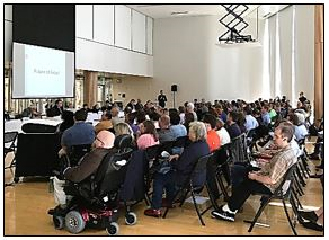 On May 9, the Access Board held a town hall meeting in Minneapolis that featured panelists from the Target Corporation's accessibility program and local speakers on outdoor recreation. The event, which was held at the University of Minnesota, also included an open forum that invited comments or questions from the public. Board Chair Deborah Ryan and Executive Director David Capozzi opened the meeting with introductions and an overview of the Board and its work.
On May 9, the Access Board held a town hall meeting in Minneapolis that featured panelists from the Target Corporation's accessibility program and local speakers on outdoor recreation. The event, which was held at the University of Minnesota, also included an open forum that invited comments or questions from the public. Board Chair Deborah Ryan and Executive Director David Capozzi opened the meeting with introductions and an overview of the Board and its work.
The first presenter was Barry Grieve who serves as Building Regulatory and Strategy Lead for the Target Corporation. He provided an overview of the work of the company's Accessibility Team which was formed 11 years ago to promote accessibility and compliance. He outlined some of the procedures and practices that have been implemented, such as conducting accessibility reviews at the outset of remodeling projects and providing access to all store check-out aisles instead of to just a portion. In addition, Target has a Digital Accessibility Team that focuses on access to the company's website and Online services. He also described related activities, including Target's membership on the ANSI A117 Committee which maintains voluntary consensus standards for accessibility referenced by the International Building Code.
Greg Lais, Executive Director of Wilderness Inquiry, followed with a presentation on access to outdoor recreation. Wilderness Inquiry is a nonprofit organization that introduces youth, families, and people with disabilities to the natural world through outdoor trips and adventures. His presentation covered accessible features at the Apostle Island National Lakeshore in northern Wisconsin and a nearby Wilderness Inquiry base camp, including accessible tent platforms, picnic tables, toilet facilities, and boardwalks. He promoted compliance with the accessibility guidelines for outdoor developed areas that the Access Board issued for federal lands in 2013 and called attention to the need for updated illustrated guides on achieving access to such sites. In addition, he recommended outreach to state student conservation corps, which help develop outdoor recreation sites, and the Corps Network on integrating accessibility into projects according to the guidelines for outdoor developed areas.
The next presenter was Elise Niedermeier who serves as the ADA Coordinator for the Minneapolis Parks and Recreation Board which oversees almost 180 outdoor sites throughout the city that total over 6,000 acres. She presented examples of access improvements completed at specific sites, including a city park, a cultural and community center, a playground, and a wading pool. She also outlined a $23.6 million plan that is being developed to improve access to existing sites. Based on an accessibility audit that surveyed over 200 sites and facilities, the plan updates an earlier transition plan and would be conducted in three phases. The first phase would involve simple corrective actions, including those that can be accomplished as part of routine maintenance, while the second phase would focus on access to recreation sites that are newly covered in the 2010 ADA Standards, including playgrounds, golf facilities, sports courts and fields, and boating and fishing facilities. The third phase features more complex corrective actions that require long range planning. A report on the plan, which is currently being finalized, will be released for public comment this summer.
During the open forum that followed the presentations, the Board invited comment from the public. Members of the audience called attention to areas where accessibility needs to be further addressed, including websites, pedestrian signals, transition planning for public rights-of-ways, and outdoor developed areas. It was noted that consensus standards for classroom acoustics that were developed with support from the Board are now applied to new school construction in Minnesota. In addition, concerns were raised about the availability of information in braille in government offices and universities, access to paper currency for people with vision impairments, and accommodations in the workplace for employees who are deaf. Several advised that action is needed on accessibility for people with age-related disabilities, morbid obesity, and deaf-blindness.
Each year, the Board substitutes one of its bimonthly meetings in Washington, D.C. with a town hall meeting in a different city. Details on next year's event will be released as they become available.
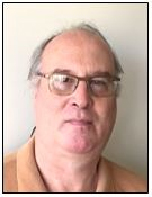 Jim Pecht, an Accessibility Specialist at the Access Board for over 25 years, will retire from government service at the end of June. Pecht joined the Board in the fall of 1991 not long after the Board issued the original ADA Accessibility Guidelines (ADAAG). In his first months on the job, he helped handle the high volume of calls on the ADA and ADAAG that the Board received through its dedicated hot-line. He continued to be a mainstay of the Board's Technical Assistance program over the full course of his tenure, providing expert technical assistance on a regular basis and conducting webinars and training sessions on ADAAG and other Board guidelines and standards.
Jim Pecht, an Accessibility Specialist at the Access Board for over 25 years, will retire from government service at the end of June. Pecht joined the Board in the fall of 1991 not long after the Board issued the original ADA Accessibility Guidelines (ADAAG). In his first months on the job, he helped handle the high volume of calls on the ADA and ADAAG that the Board received through its dedicated hot-line. He continued to be a mainstay of the Board's Technical Assistance program over the full course of his tenure, providing expert technical assistance on a regular basis and conducting webinars and training sessions on ADAAG and other Board guidelines and standards.
Pecht was active in the Board's review and update of ADAAG and led the update of companion guidelines for federally funded facilities covered by the Architectural Barriers Act (ABA). He was instrumental in coordinating these updates and harmonizing the ABA guidelines and ADAAG.
As the Board's librarian, he updated and expanded the agency's collection of technical resources, almost doubling its size. He overhauled and reorganized the library and oversaw development of a searchable database. In addition to these duties, Pecht served as the agency's lead illustrator. He created figures for the Board's guidelines and illustrated slide shows and technical bulletins, including the Online guide to the ADA and ABA Standards. He also modeled facilities and spaces for use in the Board's popular series of accessibility animations.
See how we can help your project run smoothly, with results that exceed your expectations and fit your budget.
Call 831-521-9360 or click below to fill the Consultation Form